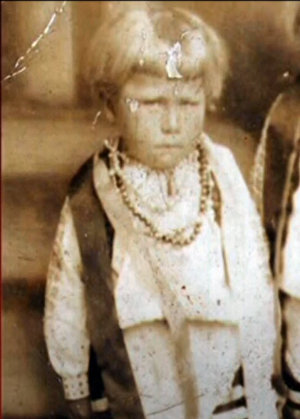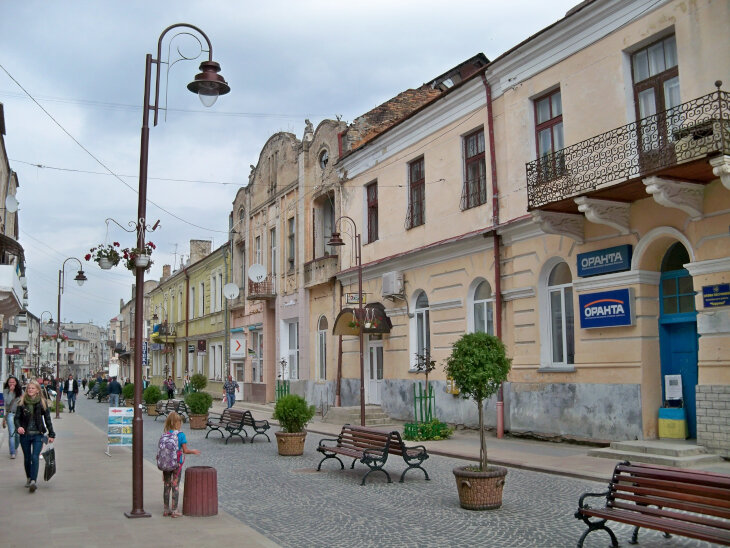 Passover’s Message of Hope in the Aftermath of Oct. 7
Passover’s Message of Hope in the Aftermath of Oct. 7


10 min read
Yaroslava Levytska is the youngest person recognized as a Righteous of the Nations for saving Jewish lives during the Holocaust.
Located about 37 miles east of Lviv, Zolochiv was once a thriving Ukrainian town. With the outbreak of World War II in 1939, large numbers of Polish Jewish refugees fled to Zolochiv, which was occupied by the Soviets. Before the Soviets retreated in 1941, Stalin’s secret police murdered several hundred Ukrainian nationalists, together with some Jewish and Polish civilians, and buried the bodies in mass graves.
When the Nazis occupied Zolochiv in July 1941, Yaroslava Levytska was a six-year-old Ukrainian girl.
My family was very poor. My grandfather Oleksandr Levytsky worked as a carpenter building churches around Zolochiv. He was a devout Greek Catholic.”
 Yaroslava Levytska, Yad Vashem Archive
Yaroslava Levytska, Yad Vashem Archive
As soon as the Nazis introduced anti-Jewish laws, Oleksandr Levytsky began supplying his endangered Jewish friends in the ghetto with food and medicine. He wouldn’t have been able to do so without the help of his young courageous granddaughter, Yaroslava, who acted as his courier without awakening the suspicions of the Ukrainian guards.
For three difficult years, this brave little girl helped her grandfather and mother carry food to Jews inside the ghetto. Wearing a backpack with food hidden under school notebooks, Yaroslava slid in through a gap in a barbed wire fence. Later, when the gap was closed, she boldly entered through the gate when guards were not paying attention.
For three difficult years, this brave little girl helped her grandfather and mother carry food to Jews inside the ghetto.
Of course it was scary, but the Germans never hit non-Jewish children,” recalls Yaroslava in an interview with Israeli journalist and historian Shimon Briman.
But one time a German hit my mother and didn’t let her bring food into a Jewish house with a red Jewish star painted on it.
We lived together with Jewish people on the same street. My father had gone to school with them. All the children loved each other, and we grew up together. We decided to help them because we were all neighbors and never even thought about their being Jewish; their nationality didn’t matter to us. Mama dressed us identically. My sister and I had little coats, and when our neighbor, Basia, a Jewish girl, outgrew her clothing we gave her a coat. When misfortune happened, we helped with whatever we had, in our souls, in our hearts; they were people, our neighbors.”
 Downtown Zolochiv
Downtown Zolochiv
The Nazis blamed the Jews for the murders committed by Stalin’s secret police. Ukrainian mobs, supported by the German authorities, went on a rampage and killed about 3000 Jews during this pogrom.
During the pogrom of July 1941, Mama didn’t let us go outside,” Yaroslava remembers. “We were told there would be a crackdown on the Jews. We took this to mean it would also happen to us. That they would be the first, and we would be next. When we saw Basia being taken away to be shot, we screamed and cried. ‘They have taken away our Basia!’ We were so sad Mama could not bear it and covered the window with a bedspread so we wouldn’t see the horrifying sight.”
Yaroslava believes it was her faith that enabled her family to hide Jews in their home, smuggle food into the ghetto and help Jewish refugees.
Yaroslava believes it was her faith that enabled her family to hide Jews in their home, smuggle food into the ghetto and help Jewish refugees.
It was our faith that motivated me and my mother and also concern for our neighbors. In April 1943, truck after truck drove into the forest where mass shootings of Jews took place. A truck with submachine gunners arrived from Lviv and the Ukrainian police took part. Neighbors said the Jews were buried in mass graves where the earth continued to move for many days.
Another terrible incident took place before my very eyes. I was walking home with two neighbor girls. We saw a truck going up a hill and a Jewish woman jumped out and began running toward us. Then a Ukrainian policeman inside the truck jumped out and also ran toward us. But the poor woman had nowhere to run. The nearest building was closed and in the other direction was barbed wire. The policeman raced after her, asking us why we were walking there. ‘Because of the lousy Jewess I might have shot a child!’ he shouted.
But he did shoot the woman. We came up to her and saw blood pouring out of her head. She was a beautiful woman, wearing a light-brown jacket. When we came home, our neighbor wrung her hands and said, ‘That was the wife of our friend, the doctor from Sasiv!’
Another time I saw two boys being shot. They were lying next to each other, and their father alongside them. Maybe policemen had shot them.”
A Jewish boy named Abram Shapiro ended up in the camp near Zolochiv. He got out and came to our neighbor’s house. She said to him: ‘I am begging you. I have one child. If I am caught because of you, they will kill you, me, and my child.’ So he crossed the road and went to our house.
Mama came and told us: ‘A boy with red hair came at four o’clock in the morning. If I am caught with him, know that if I don’t come back, they have shot both me and him.’
 Memorial at the destroyed Jewish cemetery in Zolochiv
Memorial at the destroyed Jewish cemetery in Zolochiv
We were aware of the danger but there was no question. Mama knew how to enter the ghetto unnoticed and took Abram there, telling him to say he came from the Levytskas. My grandmother made potato pancakes for him during the day which he ate cold at night. He would bring food into the ghetto like a courier. We traveled by train to our friends, taking butter and other foods. We didn’t have money, but the Jews gave us clothing which we traded for food and helped them.
The bunker where a group of Jews were hiding could be accessed only through the sewer system, but my grandfather went there. He found a boy named Yurko Shenker crying that he didn’t want to stay in the bunker. We fed Yurko who stayed with us for a few days, disguised as a girl in a dress and kerchief. So Yurko and my sister and I were walking along when suddenly a neighbor came to bring us milk. Then my father pushed Yurko with all his might to hide under the bed. We were very scared. During the night a Ukrainian policeman and my grandfather took Yurko on horseback to Pidhirtsi, and that’s how they saved him. I still have a photograph of Yurko.
In the winter, a group of Jews was brought from the ghetto to clear the snow from the road next to our house. Several of our neighbors were watching them. My father said to my mother: Make lunch, and I’ll go to the German and ask him to bring them all for lunch, so that they are not taken back to the city. The German replied: ‘I’m handing them over to you, but if even one escapes, then none of you will remain alive.’ My mother boiled a whole pail of potatoes, and my father brought bread from the bread factory. They ate, then worked until evening, and then they were brought back to the ghetto.
When the Red Army came in 1944, the Jews left the bunker, and afterwards many went to America. When the war ended the neighbors laughed at us, saying that we had rescued Jews but still remained poor with only our old house. They thought that way because others had robbed Jews of their valuables. In Pidhirtsi, people came and killed all the Jews for their gold. One little girl hidden under a bed was the only survivor. Later some Jews came and beat the Ukrainians for betraying the Jews they promised to hide for money. The grain storehouse in Zolochiv was built with the red bricks of a ruined synagogue. When the Jewish cemetery was destroyed, Jewish names were erased from some headstones which were placed next to the church with new names.
The Russians sent my grandfather and grandmother to Siberia but later released them. After the war, the Muscovites beat my father and shouted at him, ‘You Banderite!’ (Ukrainian nationalist).”
Only 90 Jews, one percent of the prewar population of nine thousand Jews in Zolochiv, had survived. A third of those survivors were saved by the Levytsky family.
According to Yad Vashem, by the time of the liberation in the summer of 1944, only 90 Jews, one percent of the prewar population of nine thousand Jews in Zolochiv, had survived by hiding in bunkers, sewer systems, and pits in the forest. A third of those survivors were saved by three generations of the Levytsky family: the grandfather Oleksandr, his daughter Kateryna, and young granddaughter, Yaroslava.
Abram Shapiro was saved and after the war he joined his brother who was living in Haifa.
In 1989 Abram invited me to come to Israel to receive the title of Righteous of the Nations and a medal from Yad Vashem,” recalls Yaroslava. “He drove me around the country in his car. He thanked our family very much. Abram and I communicated in the Ukrainian language. He understood and knew everything. While I was in Israel, people asked me about the economic situation back in Ukraine which was very difficult, especially as my parents had just died.”
Yaroslava started to find out about state programs that help righteous heroes relocate to Israel. In 1995, in appreciation for her bravery during the Holocaust, Israel granted Yaroslava full Israeli citizenship, a pension, and an apartment in Haifa.
She had lived for many years under a communist regime that suppressed religion. “Now I live in Haifa, a city of three religions, Judaism, Islam, and Christianity, and I go to a church with a priest who prays in Ukrainian, and no one bothers us,” she points out. She receives visits and medical assistance from an Israeli charity called Atzum, which has a project dedicated to helping the righteous.
I feel extremely fortunate for the fact I live in Israel,” says Yaroslava. “I don’t have the words to express it.”
That was two years ago, before the latest war started raging in Ukraine, shattering the lives of millions across the country and the fighting still continues. One month ago, on June 17, 2022, the Russians shelled Zolochiv with cluster munitions, injuring an eighty-two-year-old woman who might have been a childhood friend of Yaroslava.
In Haifa’s Garden of the Righteous there are 18 memorial stones bearing the names of those who risked their lives to save Jews during the Holocaust. Yaroslava Levytska is the only person to be honored with this commemorative marker during her lifetime.
